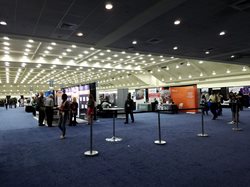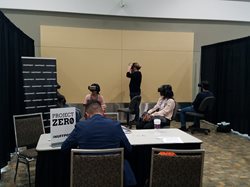by Mandy Izzo
Sr Science Writer, Institute for Disease Modeling
Attending scientific conferences has always been one of my favorite activities within the research community. The electric atmosphere that results from being surrounded by hundreds of your enthusiastic peers creates a feeling of being at “science camp”—some work, a lot of novelty, tons of fun, and incredible engagement with bright minds that share your interests. There’s such an energy among the attendees, that it’s impossible not to become inspired, engaged, and to enjoy a refreshed interest in your work.
Conferences serve many purposes; ultimately they bring together research communities so that ideas and solutions can be discussed and shared. For researchers, they often act as benchmarks or check points, such that progress can be measured by what you are able to present each year. Collaborations form, as you can interact with both bright new up-and-comers and hob-knob with your academic heroes. Additionally, they provide a forum to show off new technologies and products that can help tie research to practical applications.
In many ways, ASTMH is your typical conference. It aims to coordinate the international community of doctors, academics, researchers, policymakers, and other parties interested in public health in a forum used to explore the current state of global health with an emphasis on how to move forward. However, for me, ASTMH represents some firsts. It is the first time I am attending such a large meeting: there are over 3400 attendees from over 100 countries! This is a massive conference, and truly embodies an international community. It is also my first time attending a conference on public health. My experience stems from evolutionary biology and ecology, and most of the medical presentations I’ve attended typically came from medical entomologists presenting work on ecological applications. Luckily, after attending several sessions, I can report that my interest is every bit as piqued and the inspiration is just as strong as from my favorite biology conferences. As a science writer, it’s been a blast to once again run amok at “science camp,” and attending ASTMH is already inspiring me with new ideas and concepts to try with my work!

Some highlights so far:
Sunday Nov 5 was the first day of the conference. Numerous pre-meeting workshops take place, as so many people converge from all over the world to attend; however, the conference officially began on Sunday. They keynote address, delivered by Paul Farmer, MD, PhD, who is the Co-founder and Chief Strategist of Partners in Health (PIH), was a somber examination of the lack of equity in both healthcare systems and plans for emergency responses for public health crises. Using examples from the Cholera epidemic in Haiti and the Ebola epidemic in Libera, Dr. Farmer demonstrated how the missing “staff, stuff, space, and systems” necessary for adequate response and care can exacerbate already difficult situations. The integration of social, political, and ecological issues often act to create public health problems, and when natural disasters strike, epidemics typically follow.
For Ebola, one of the most striking reasons for the rapid spread of disease stemmed from missed opportunities for prevention. For such a deadly disease—one survivor lost 22 family members from it—missing out on simple avenues of prevention is devastating. This lack in basic care and prevention often stems from fundamental issues in regional healthcare systems. Unfortunately, emergency response plans tend to ignore these issues, and efforts are not enacted to fix or rebuild these systems during or after healthcare crises. To compound the problem, less than 25% of funds pledged to areas in need tend to ever get paid out or used for anything meaningful. Looking at the numbers presented by Dr. Farmer is almost enough to wonder why we don’t see even
more major health crises in low-resource settings.
Fortunately, there are incredible people working towards alleviating global burdens of disease. An example of these efforts is HuffPost’s Project Zero (
https://www.huffingtonpost.com/topic/project-zero), an ongoing series whose aim is to raise awareness of neglected tropical diseases to better combat them. At ASTMH, HuffPost has an exhibit with three virtual reality films: one on sleeping sickness, one on elephantiasis, and one on river blindness. These VR documentaries are incredibly immersive and engaging, in a way that is simply not possible with typical movies (or text books).

When watching them, you are surrounded by the people experiencing these diseases; you are sitting with them in their village, boating with them down a river, dancing with them during a celebration. You have what feels to be a real-life perspective of what their world is like: you see their environment as they do, you engage with it as they do. It’s incredibly sobering…In the film on sleeping sickness, you sit by the bedside of a patient getting treated, and then you sit in front of a table filled with all of the medication required for one person to take. The sheer volume of what’s needed is overwhelming, especially after the travel it took to get to the village in the first place. When you are then shown the new experimental treatment—a small case of 3 pills—the impact is enormous. The ability of these VR movies to engage audiences, and to help fight for support and cures is incredible.
Overall, I have been overwhelmed by the research presentations, exhibits, and interactions with new colleagues and old friends. And it’s only the first day!